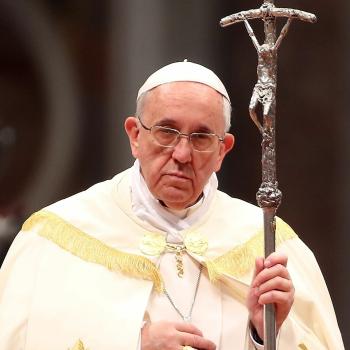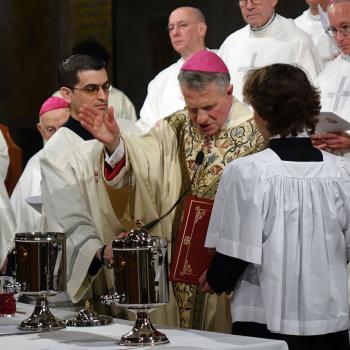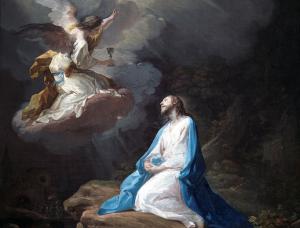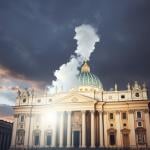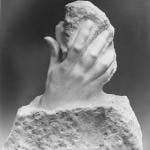
Before Pope Saint John Paul II added the Luminous Mysteries to the traditional Joyful, Sorrowful, and Glorious ones, I felt something was missing. I wondered if, among other things, the Transfiguration ought to have been included. I would have put the Transfiguration with the Glorious Mysteries, though. John Paul II did much more than add some mysteries to the Rosary. He brought the whole working career of Jesus into this important part of the prayer life of the Church.
There are theologies of salvation, soteriologies, that emphasize the Incarnation, Jesus’ becoming one of us. Others stress the Crucifixion or the Resurrection or a combination of the three. Somehow, Jesus, who lived and walked the earth, seems absent. But it was Jesus’ life that led him to the cross. It was that life, not just the suffering, that God approved in the Resurrection.
Words for the five Luminous Mysteries:
For a non-visual person like me, words work better then imagination for focusing on the meaning of the mysteries. I find three places in a decade for these words from Scripture.
- The Baptism of Jesus. A voice came from the heavens, You are my beloved Son; with you I am well pleased.” (Mark 1:11)
- The Miracle at the Wedding Feastof Cana. Mary said, “Do whatever he tells you.” The headwaiter said, “You have kept the good wine until now.” (John 2:1-10)
- The Proclamation of the Kingdom. After John’s arrest Jesus began to proclaim, “This is the time of fulfillment. TheKingdom of God is at hand. Repent and believe in the gospel.” (Mark 1:14)
- The Transfiguration. Peter said, “Let us build three tents, one for you, one for Moses, and one for Elijah.” A voice came from a cloud: “This is my beloved Son. Listen to him.” (Mark 9;2-8)
- The Institution of the Eucharist. “This is my body, which will be given for you. … This cup is the new covenant in my blood, which will be shed for you.” (Luke 22:19)
Some thoughts about the five Luminous Mysteries:
- First Mystery, the Baptism of Jesus. Jesus’ baptism by John is one of the surer events in Jesus’ life, purely historically speaking. It’s a story the Gospel writers had to include even though it made them uncomfortable that anyone would baptize Jesus. … Mark reports that John baptized people in the Jordan, but Jesus he baptized into the Jordan. Maybe only Jesus went completely under? That could mean many things: Dying and rising. Setting aside former things and starting something new. Total identification with a people and a culture that, in important ways, never made it through to the “Promised Land.”
- Second Mystery, Changing Water into Wine at the Wedding Feast at Cana. John the Evangelist didn’t have to write this story, but he did and featured it prominently at the beginning of Jesus’ ministry. Regardless of what we might think of people getting drunk at weddings, both the wedding and the wine are important to John. The wine, plenty for everyone at the feast, brings to mind blood that Jesus sheds for all. We’ll remember the wedding when in the next chapter John the Baptist refers to Jesus as the Bridegroom. … Unlike the first three Gospels, John’s Jesus never says what the Kingdom of God is like. But here we find that it is like nothing so much as a wedding feast. … In the headwaiter’s preference for Jesus’ wine, the evangelist symbolizes a raising of Jesus’ message over that commonly heard in Israel.
- Third Mystery, the Proclamation of the Kingdom. Jesus names our first two responses to the Kingdom that is at hand: Repent and believe in the Good News. He was not saying, “Be sorry for your sins and everything will be OK for you.” God’s Kingdom exists where “the blind regain their sight, the lame walk, lepers are cleansed, the deaf hear, the dead are raised, and the poor have the good news proclaimed to them.” (Matthew 11:5) Repenting is more like re-thinking, re-imagining the world God’s way; and believing is the first part of leaping into Kingdom work.
- Fourth Mystery, the Transfiguration. I imagine Jesus was transfigured in prayer often. Mark puts his Transfiguration story on a mountain with Moses and Elijah. Moses represents the Law and Elijah represents the Prophets. The third section of Hebrew Scriptures is the Writings, or Wisdom. That would be Jesus, of whom the voice from the cloud, appropriately, says, “Listen to him.” In all three synoptic Gospels Jesus has recently taught about his passion, which Peter couldn’t accept; and he said taking up one’s cross was a condition of discipleship. It contradicts Peter’s (and our) triumphalistic imaginings concerning the following of Jesus.
- The Fifth Luminous Mystery, the Institution of the Eucharist. Words fail me. I use my feeble imagination. Everyone sees Jesus hold up the loaf of unleavened bread. Jesus has arranged beforehand that there would be only one, just like in the boat when the disciples thought one loaf wasn’t very much. The apostles have tried to find some mystical meaning in Jesus’ three predictions of his passion, anything other than what he plainly said. Now they hear him say, “This is my body, which will be given for you” — and he breaks it, literally. He passes a piece to either side of him. It is enough. … Jesus lifts a cup of wine. “This is the new covenant in my blood.” … That is the end of Jesus’ verbal interpretations. He makes no comment on the Paschal lamb slaughtered especially for this feast. Later disciples realize, He is the Lamb.




